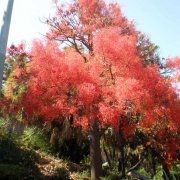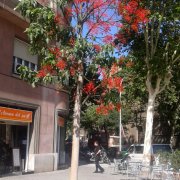Care of the tree Brachychiton acerifolius or Flame tree |
|
The genus Brachychiton, family Malvaceae, comprises 30 species of shrubs and trees native to Australia. Some species are: Brachychiton acerifolius, Brachychiton bidwillii, Brachychiton discolor, Brachychiton populneus, Brachychiton rupestre. Common names: Flame tree, Flame bottletree, Illawarra flame tree. This species is native to the east coast of Australia. They are semi-deciduous trees with a straight trunk and a pyramidal crown that reach 15 meters (49.2 feet) in height. They have leathery leaves with 5-7 bright green lobes on the upper side. The showy bell-shaped flowers are deep red in color and appear before the leaves. They bloom in spring. The fruits are dark pods shaped like a boat. These fast-growing, long-lived trees are used as isolated specimens in mid to large gardens, in public streets and parks, or even in pots. It's suitable for Mediterranean coastal gardens but not on the seafront. It combines very well with Jacarandas. Brachychiton acerifolius can grow in full sun or semi-shade exposure and prefers dry winters. It resists occasional frosts but it is better not to expose them to less than 4 ºC (39.2 ºF). Flame tree grows in almost any type of soil but prefers that it is well drained, deep and contains organic matter. Water regularly in summer without letting the substrate dry out completely. From 8-10 years of age they resist drought well. In spring, fall and winter water moderately waiting for the soil to dry out. Fertilize with organic matter in autumn and with slow-release mineral fertilizer in early spring. Illawarra flame tree does not usually need pruning. Brachychiton acerifolius is a tree resistant to the usual pests and diseases. Flame bottletree propagates by seeds sown in spring or by cuttings in late summer or fall. |
Images of the tree Brachychiton acerifolius or Flame tree |
Find plants
Brachychiton acerifolius or Flame tree | Care and Growing
© 2025 FavThemes





